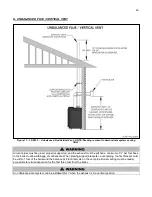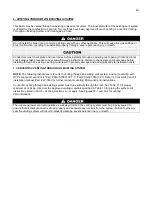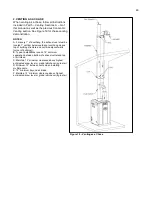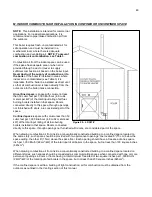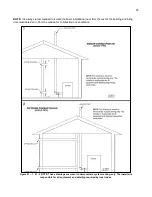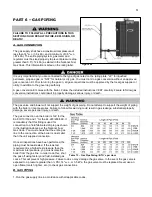
36
D. EXHAUST VENT AND INTAKE AIR VENT PIPE LOCATION
You must insert the provided intake and exhaust screen at your vent termination to prevent blockage caused by
debris or birds.
NOTE: SEE ADDITIONAL REQUIREMENTS FOR MASSACHUSETTS IN THE BACK OF THIS MANUAL.
1. Determine exhaust vent location:
Total length of vent may not exceed the limits specified in Part 5 Section E.
The vent piping for this boiler is approved for zero clearance to combustible construction.
See Venting Details within this section of clearances for location of exit terminals of direct-vent venting
systems.
Avoid terminating exhaust vents near shrubs, air conditioners or other objects that will obstruct the
exhaust stream.
The flue products coming from the exhaust vent will create a large plume when the boiler is in operation.
Avoid venting in areas that will affect neighboring buildings or be considered objectionable.
The boiler vent system shall terminate at least 3 feet (0.9 m) above any forced air intake located within 10
ft (3 m).
NOTE
: This does not apply to the combustion air intake of a direct-vent appliance.
Provide a minimum of 1 foot distance from any door, operable window, or gravity intake into any building.
Provide a minimum of 1 foot clearance from the bottom of the exhaust above the expected snow
accumulation level. Snow removal may be necessary to maintain clearance.
Provide 4 feet horizontal clearance from electrical meters, gas meters, gas regulators, relief equipment,
exhaust fans and inlets. In no case shall the exit terminal be above or below the aforementioned
equipment unless the 4 foot horizontal distance is maintained.
Do not locate the boiler exhaust over public walkways where condensate could drip and/or freeze and
create a nuisance or hazard.
When adjacent to a public walkway, locate exit terminals at least 7 feet above grade.
To prevent icicles from forming, do not locate the exhaust directly under roof overhangs.
Provide 6 feet of clearance from the inside corner of vertical walls, chimneys, etc., as well as horizontal
corners created by roof overhangs.
2. Determine air intake vent location:
Provide 1 foot of clearance from the bottom of the intake vent and the level of maximum snow
accumulation. Snow removal may be necessary to maintain clearances.
Do not locate the intake air vent in a parking area where machinery may damage the vent.
Follow required minimum clearances located in Figure 11.
NOTE:
Due to potential moisture build-up, sidewall venting may not be the preferred venting option. To save time
and cost, carefully consider venting installation and location.
The building owner is responsible for keeping the exhaust and air intake terminations free of snow, ice, or other
potential blockages, as well as scheduling routine maintenance. Failure to keep the vent piping terminations clear
and properly maintain the boiler could result in property damage, severe personal injury, or death.
For each floor containing bedroom(s), a carbon monoxide detector and alarm shall be placed in the living area
outside the bedrooms, as well as in the room that houses the boiler. Detectors and alarms shall comply with
NFPA 720 (latest edition). Failure to comply with requirements for detectors and alarms could result in property
damage, severe personal injury, or death.
Содержание EL-110
Страница 15: ...15 Figure 3 ...
Страница 61: ...61 Figure 29 ...
Страница 62: ...62 Figure 30 ...
Страница 87: ...87 Figure 33 ...
Страница 88: ...88 Figure 34 ...
Страница 89: ...89 Figure 35 LP 293 A NOTE Parts listed on the following page ...
Страница 94: ...94 ...
Страница 95: ...95 ...
Страница 96: ...96 MAINTENANCE NOTES ...
























